CABP: Good morning. What are some natural gas applications where deliquescent dehydrators are used?
Van Gas: Good morning. When natural gas emerges from the ground, it bears little resemblance to the clean-burning natural gas used in our factories and homes. At the well site, natural gas is saturated with water, contains heavy liquid hydrocarbons, oil and even rocks and sand! Sophisticated treatment systems, of different types, purify natural gas before it can enter a utility transmission line and then enter a business or home.
Most of this gas treatment takes place in centralized processing plants. Triethylene glycol (TEG) dehydrators are the most prevalent technology for removing water vapor from natural gas . Molecular sieve dryers are also quite common in gas processing plants. Molecular sieve units have operating processes similar to industrial heat-regenerated compressed air dryers. Natural gas, however, often needs to be purified at the wellhead before reaching the processing plant. Deliquescent dehydrators are normally used, in remote locations where no power supply exists, to dry small gas volumes located between the wellhead and these main treatment plants. The most common applications are instrument gas, fuel gas, sales gas, and emissions mitigation.
CABP: Please describe Instrument Gas dehydration.
Van Gas: Instrument Gas is a term used for the gas required to support the surface equipment using pneumatic-actuated valves for flow control and drainage. This surface equipment is located at the wellhead and other sites before the processing plant. All of this equipment is remote-located in a field, desert or mountainside – where there is no power supply. In remote areas, you don’t have any electric power supply to support an electric-motor driven air compressor able to support the pneumatic controls. Therefore, natural gas operators use their own product - pressurized gas- to operate these pneumatic control systems. Thus the term instrument gas.
This instrument gas is saturated with moisture and as there is no electric power source, operators need a simple, power-less means to dry the gas. This is where deliquescent dehydrators come in. Small deliquescent dryers are typically attached to the side of a production separator tank. Three-phase production separators, at the wellhead, represent the first step in splitting apart gas, liquids, and oil. The separators use automated valves connected by small tubing runs which must be kept clean and dry. Small deliquescent dehydrators dry these very small volumes of instrument gas to keep actuators from freezing. A frozen instrument gas line, on a production separator, will potentially shut down a well.
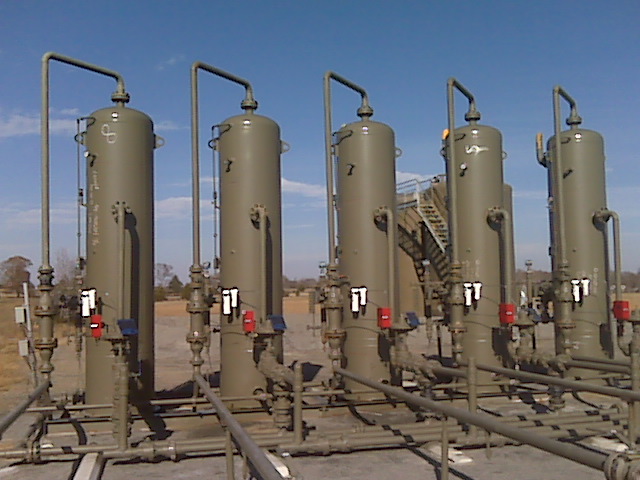
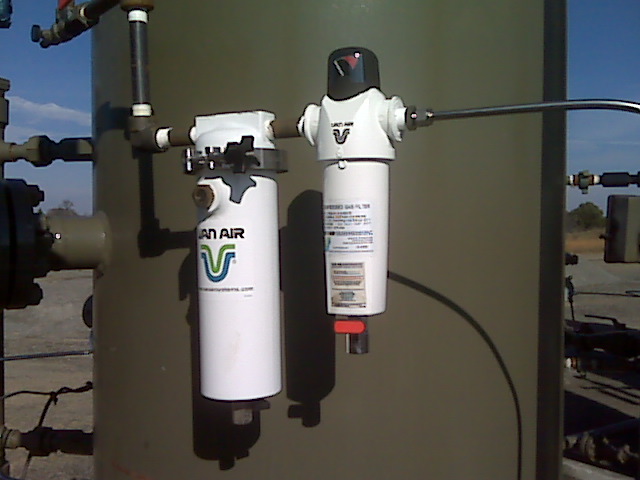
Instrument gas dryers, with 1 Micron Particulate Prefilters, protect valves on production separators
CABP: What are the Fuel Gas applications?
Van Gas: Fuel gas applications, for deliquescent dryers, are again located at the well head or somewhere before the first processing plant. These outdoor sites do not have any electric power supply and a robust dryer is needed able to withstand wind, rain, snow and whatever Mother Nature throws at us! Natural gas operators often need dry natural gas to support heating, rotating equipment, and flares.
Heating requirements in the field can include space-heating a building. Small buildings are often erected, in remote sites where it gets very cold, for shelter for personnel and equipment. Another heating application is heaters for oil tanks. It’s hard to burn wet gas so small deliquescent dryers are used to dry the fuel.
When gas compression is required near the wellhead, natural gas compressors are used. The gasends are often driven by reciprocating natural gas-fired engines. These engines need the humidity level in their fuel reduced as burning saturated gas can cause problems.
Many well pads will use a flare to destroy waste vapors coming off tanks (for example). A flare has a pilot light that needs to be ready to go at a moment’s notice. If that fuel is coming from an untreated source, it has to be dried. You can’t have the pilot light area freezing up due to moisture present in the gas stream. Located in a little 1/8” stainless steel tube, if that pilot light freezes up, it won’t ignite.
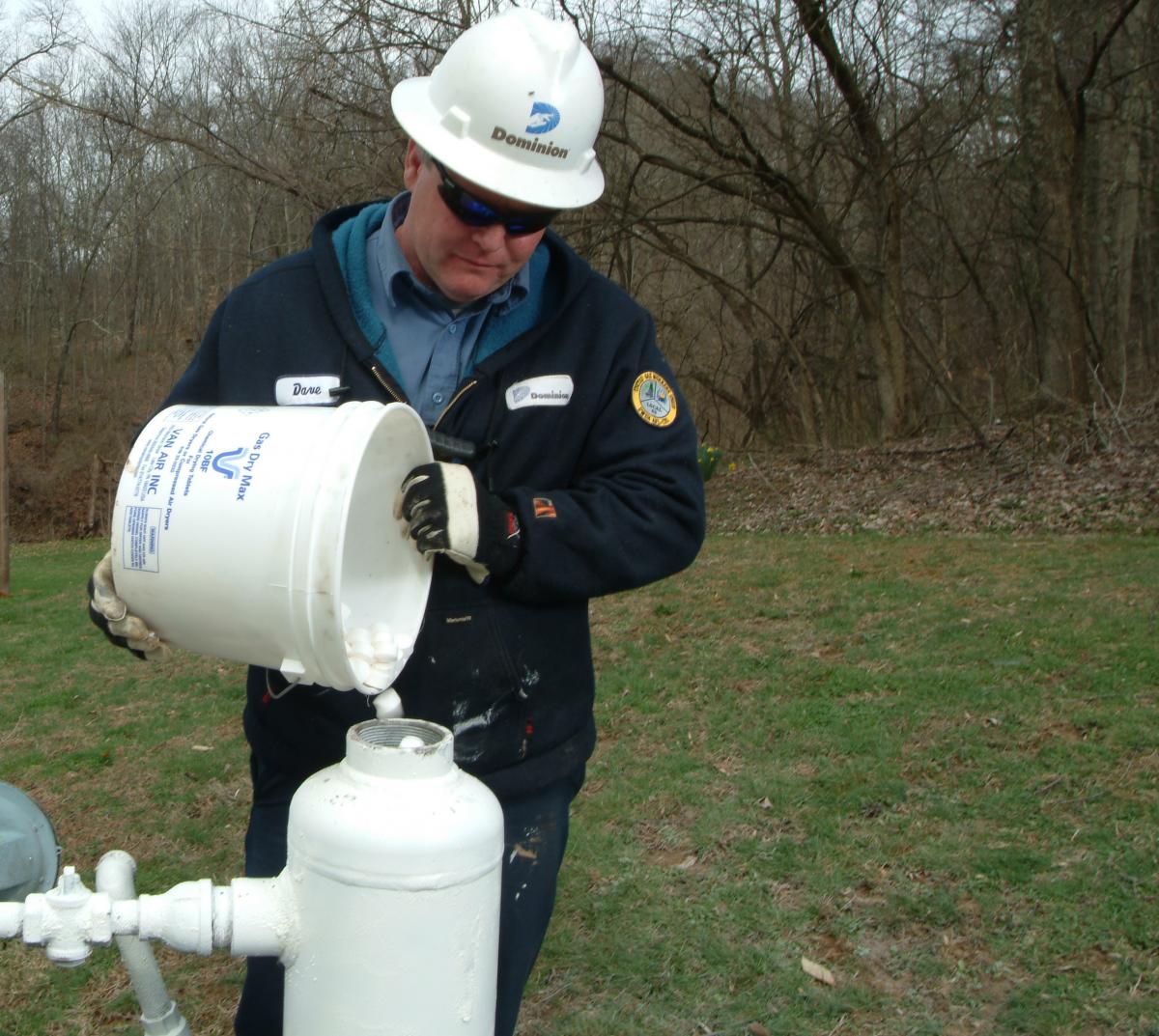 |
|||
An 8” diameter with GasDry Max desiccant at a farm tap in West Virginia. The owner of the well must dry the gas in order to meet a sales gas moisture specification. |
|||
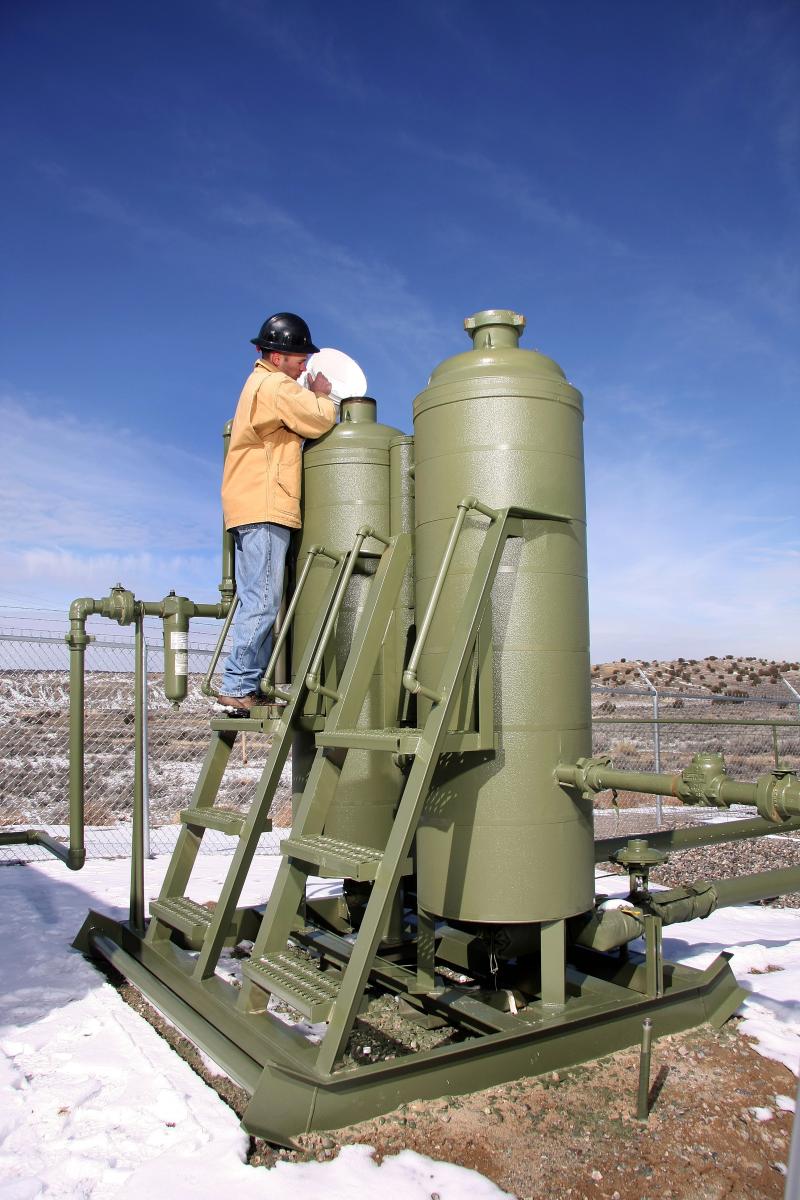 |
|||
Dual 20” diameter deliquescent gas dryers condition field gas that is being used to fuel a series of small gas turbines. The turbines produce electricity at a remote location without access to grid power. The first vessel is filled with GasDry Prime desiccant. The second vessel is filled with GasDry Max desiccant. |
CABP: I see Van Air Systems / Van Gas products as I drive around here in Western Pennsylvania.
Van Gas: Yes, the deliquescent dryers you see on country roads are what we refer to as “Sales Gas” applications. “Farmer Jones” has a small well (referred to as a Farm Tap) and is selling gas into a local natural gas pipeline. In order to sell the gas, before it’s inserted into the line, he needs a simple way to extract humidity from his gas. Van Gas Technologies has supplied thousands of deliquescent gas dryers installed in the legacy, shallow wells of the Appalachian basin located in Western Pennsylvania, Ohio, New York, and West Virginia.
Sales gas refers to the product the operator is selling. The customer is usually another gas company. There are usually moisture and purity specifications that have to be met to complete a sale. There are many transactions along the supply chain. There are many, many cases where operators want to sell gas to a certain specification but they don’t have access to a treatment plant and they need to get some drying done to complete a sale. This is where deliquescent dryers are often used right at the custody transfer point between gas operators.
CABP: Please discuss emission mitigation and how deliquescent desiccants fit in.
Van Gas: Newer plays, like in the Marcellus Shale, have large-scale infrastructures with centralized treatment plants. As mentioned before, far and away the most prevalent way to dry natural gas is to use Triethylene Glycol (TEG) Dehydrators. This process, however, produces emissions for which each operator is allotted permission to emit to a certain level. Once they reach their emissions limit, they have to cut back production.
Gas dryers using deliquescent desiccant do not create any emissions and there are situations where they have been used in lieu of a TEG system. We work with a gas producer in southern California operating some wells on some artificial islands just off the coast of Long Beach. They could not get a TEG system permitted due to emissions. Instead they now operate several large deliquescent dryers since our process doesn’t vent any gas.
CABP: Please describe the deliquescent tablets.
Van Gas: Deliquescent desiccants have been used to dehydrate natural gas, by the oil and gas industry, for over 70 years. Desiccants are made up of hygroscopic salts, such as calcium chloride, lithium chloride and potassium chloride. Desiccants attract and absorb water vapor, which gradually dissolves the desiccants into brine. This process is called ‘deliquescing’. The amount of moisture removed from the gas depends on the type of desiccant. Calcium chloride, the most common and least expensive desiccant, removes approximately 67% of the water vapor in natural gas. Lithium chloride based desiccants, which are more expensive, remove approximately 87% of the water vapor in natural gas. Our desiccants come in a pressed tablet form. They’re ultimately packed into a bed within a vertical pressure vessel. The vessel is called the dryer or dehydrator.
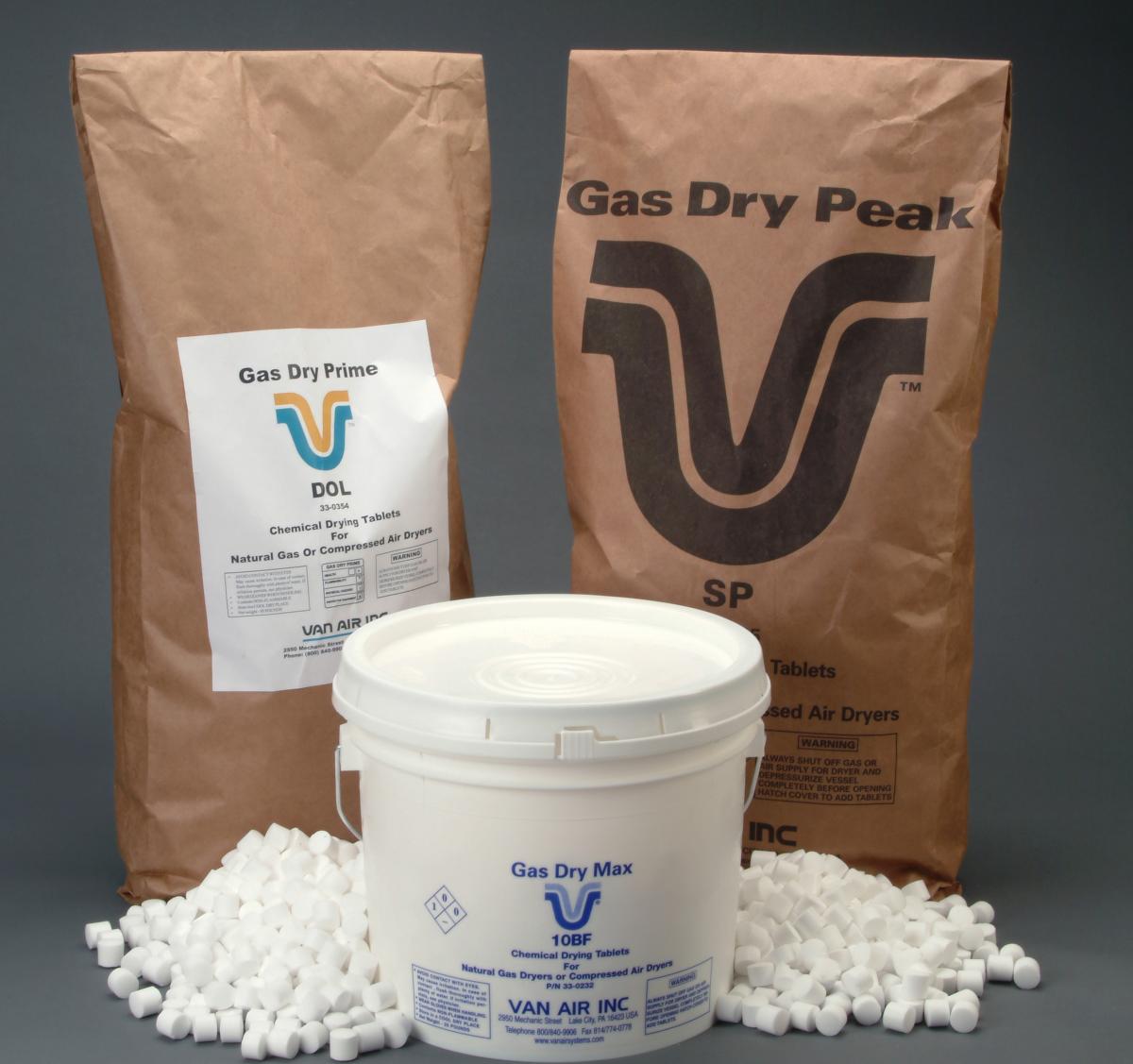
Van Gas Technologies produces three grades of deliquescent desiccant: GasDry Prime, GasDry Peak, and GasDry Max. The grade selection depends on operating conditions and the required outlet dew point.
CABP: Can you provide a drying process description?
Van Gas: Sure. Deliquescent drying is a very simple process; it has no moving parts and needs no external power so that it can be used in offshore or remote sites. Wet natural gas enters the dehydrator vessel below the desiccant support grid and flows up through the desiccant bed. The support grid prevents the desiccant tablets from dropping into the brine sump. The wet gas flows upward through the support plate and the drying bed, where it contacts the desiccant tablets. The moisture from the gas is absorbed by the tablets and accumulates on the surface of the tablets. Gradually the moisture dissolves the desiccants into brine droplets, which trickle down into the claim area that is connected to a brine storage tank. When the desiccants reach equilibrium or the maximum amount of moisture they can adsorb, the ‘dry’ gas exits on the top of the vessel to the main gas line.
CABP: How is the liquid removed from the tank and how is the desiccant “regenerated”?
Van Gas: Smaller units, used for minimal flows, are usually manually drained. They see so little flow that a couple of teaspoons of condensate is gathered in buckets during the weekly maintenance procedures.
In larger dehydrators, draining is done automatically with a pneumatically-controlled float drain inserted into the sump area of the vessel. Larger units with pressure vessel diameters ranging from 12” to 48” inches these will produce several gallons per day of this brine (a salty liquid). This brine is then sent to the wastewater tank located at the site. Almost all wellheads have large wastewater tanks to capture the liquids coming off the production separator. The volume of liquid coming from the dryer is a small percentage of the wastewater being accumulated in these tanks.
The tablets are not regenerated. They’re a consumable product. New tablets are normally added to the vessel on a 45-60 day cycle by the operator. The tablets are packed in 25-50 lbs. bags and are manually poured through ports in the top of the pressure vessel.
CABP: Thank you for sharing this information.
For more information contact Tyler Currie, Vice President Business Development, Van Air Systems and Van Gas Technologies.
For more Natural Gas articles, visit www.airbestpractices.com/industries/oil-gas.




